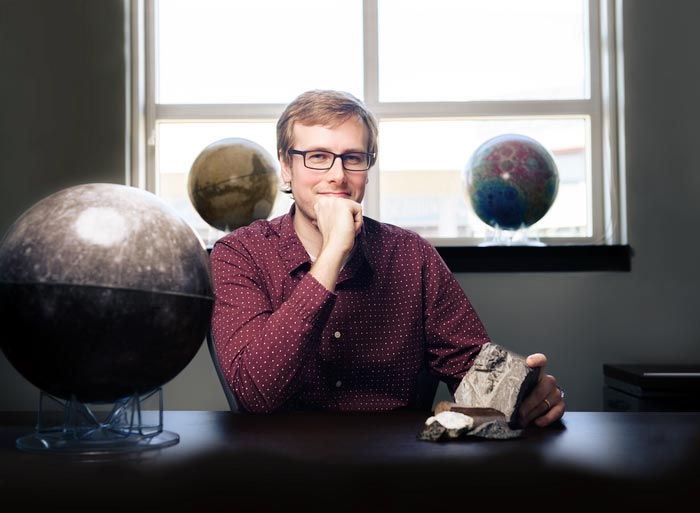Breaking in a new planet

Brandon Johnson, an expert in impact crater dynamics, surrounded by some of his favorite research subjects: Mercury, Mars and the moon.
Credit: Purdue University photo/Rebecca McElhoe
Impacts affect the porosity and structure of moons and planets more dramatically than scientists suspected, increasing their potential habitability for life.
The harder you hit something – a ball, a walnut, a geode – the more likely it is to break open. Or, if not break open, at least lose a little bit of its structural integrity, the way baseball players pummel new gloves to make them softer and more flexible. Cracks, massive or tiny, form and bear a silent, permanent witness to the impact.
Studying how those impacts affect planetary bodies, asteroids, moons and other rocks in space helps planetary scientists including Brandon Johnson, associate professor, and Sean Wiggins, postdoctoral researcher, in the College of Science’s Department of Earth, Atmospheric, and Planetary Sciences at Purdue University, understand extraplanetary geology, especially where to look for precious matter including water, ice and even, potentially, microbial life. A YouTube video is available online.
Every solid body in the solar system is constantly pummeled by impacts, both large and small. Even on Earth, every single spot has been affected by at least three big impacts. Using the moon as a test subject, Johnson, Wiggins and their team set out to quantify the relationship between impacts and a planet’s porosity.
The researchers used extensive lunar gravity data and detailed modeling and found that when large objects hit the moon or any other planetary body, that impact can affect surfaces and structures, even very far away from the point of impact and deep into the planet or moon itself. This finding, detailed in their new study published in the journal Nature Communications, explains existing data on the moon that had puzzled scientists. The research was partially funded by funded by NASA’s Lunar Data Analysis Program.
“NASA’s GRAIL (Gravity Recovery and Interior Laboratory) mission measured the gravity of the moon and showed that the moon crust is very porous to very great depths,” Johnson said. “We didn’t have a description of how the moon would get so porous. This is the first work that really shows that large impacts are capable of fracturing the moon’s crust and introducing this porosity.”
Understanding where planets and moons have fractured, and why, can help direct space exploration and tell scientists where the best place to look for life might be. Anywhere that rock, water and air meet and interact, there is a potential for life.
“There’s a lot to be excited about,” Wiggins said. “Our data explains a mystery. This research has implications for the early Earth and for Mars. If life existed back then, there were these intermittently big impacts that would sterilize the planet and boil off the oceans. But if you had life that could survive in pores and interstices a few hundred feet or even a few miles down, it could have survived. They could have provided these refuges where life could hide out from these kinds of impacts.
“These findings have a lot of potential for directing future missions on Mars or elsewhere. It can help direct searches, tell us where to look.”
Journal: Nature Communications
DOI: 10.1038/s41467-022-32445-3
Article Title: Widespread impact-generated porosity in early planetary crusts
Article Publication Date: 16-Aug-2022
Media Contact
Brittany Steff
Purdue University
bsteff@purdue.edu
Office: 765-494-7833
Cell: 317-439-0771
All latest news from the category: Physics and Astronomy
This area deals with the fundamental laws and building blocks of nature and how they interact, the properties and the behavior of matter, and research into space and time and their structures.
innovations-report provides in-depth reports and articles on subjects such as astrophysics, laser technologies, nuclear, quantum, particle and solid-state physics, nanotechnologies, planetary research and findings (Mars, Venus) and developments related to the Hubble Telescope.
Newest articles

A universal framework for spatial biology
SpatialData is a freely accessible tool to unify and integrate data from different omics technologies accounting for spatial information, which can provide holistic insights into health and disease. Biological processes…

How complex biological processes arise
A $20 million grant from the U.S. National Science Foundation (NSF) will support the establishment and operation of the National Synthesis Center for Emergence in the Molecular and Cellular Sciences (NCEMS) at…

Airborne single-photon lidar system achieves high-resolution 3D imaging
Compact, low-power system opens doors for photon-efficient drone and satellite-based environmental monitoring and mapping. Researchers have developed a compact and lightweight single-photon airborne lidar system that can acquire high-resolution 3D…





















